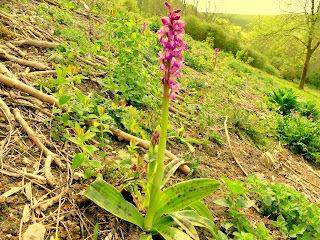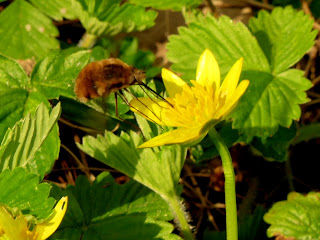In preparation for a walk on Sunday in a few days (details here at Mid Sussex Ramblers), the route was checked out today.
Wolstonbury Hill is a fine example of rare chalkland habitat. And the grassland is being invaded by scrub and trees. Over the years The Friends of Wolstonbury have tackled this encroachment under the direction of National Trust ranger, Mike Botterill. This day I visited the area which has been cleared in recent month. My hope was to see dormant orchids flowering but to no avail.
Nice though, was to see a beefly honing in on Ground Ivy and some bumblebees that I didn't photograph
For illustrated talks on natural history and history see www.peterlovetttalks.co.uk
For illustrated talks on natural history and history click here for www.peterlovetttalks.co.uk
Monday, 29 April 2019
Some birds on Wostonbury Hill today; Yellowhammers, Skylarks, a Kite and a Buzzard
It was for Early-purple orchids that I was on the hill today.
Some birds seen included;
Yellowhammers a long way off.
A Red Kite, I presumed, which flew past and was quickly gone. Perhaps it was the Black Kite seen at Wiston this day and reported on https://www.sos.org.uk/recent-sightings as flying eastwards [to Wolstonbury perhaps?].
Skylarks were common.
And a buzzard posed for some pic's.
Some birds seen included;
Yellowhammers a long way off.
A Red Kite, I presumed, which flew past and was quickly gone. Perhaps it was the Black Kite seen at Wiston this day and reported on https://www.sos.org.uk/recent-sightings as flying eastwards [to Wolstonbury perhaps?].
Skylarks were common.
And a buzzard posed for some pic's.
Fornicating flies, Bibio anglicus
A pair of fornicating flies settled on my trousers this afternoon on the Downs. Click on any picture to enlarge it.
They obligingly crawled onto my finger without disturbing their copulation activity. They are Bibio anglicus.
The male has a big head and big eyes. The female has a smaller head and smaller eyes. Her head is black and her body redish.
They obligingly crawled onto my finger without disturbing their copulation activity. They are Bibio anglicus.
The male has a big head and big eyes. The female has a smaller head and smaller eyes. Her head is black and her body redish.
Friday, 26 April 2019
Friday, 19 April 2019
Osmia caerulescens, Blue Mason Bees yesterday in West Sussex.
This green-eyed bee was investigating a hole in a fence post in Cuckfield, West Sussex, from where a six inch nail had been removed some years ago.
Thanks to Kim Leaver on https://www.facebook.com/groups/1590641777855221/?multi_permalinks=2260694824183243&comment_id=2262001780719214¬if_id=1555930558226114¬if_t=feedback_reaction_generic
it is identified as a Blue Mason Bee male, Osmia caerulescens.
And above is the female from the same day in the garden. Many thanks Kim for your help and advice.
Thanks to Kim Leaver on https://www.facebook.com/groups/1590641777855221/?multi_permalinks=2260694824183243&comment_id=2262001780719214¬if_id=1555930558226114¬if_t=feedback_reaction_generic
it is identified as a Blue Mason Bee male, Osmia caerulescens.
And above is the female from the same day in the garden. Many thanks Kim for your help and advice.
Thursday, 18 April 2019
Orange-tip butterflies enticed into a Sussex garden. Patience is rewarded.
Last year cuckoo flowers were left to grow in the flower borders of my Sussex garden, specifically to encourage butterflies. One year later they are blooming well.
According to https://butterfly-conservation.org, several crucifers are used as caterpillar foodplants, especially Cuckooflower (Cardamine pratensis), above in my garden and Garlic Mustard (Alliaria petiolata), which were also selectively allow to grow.
Today my patience was rewarded with a female Orange-tip, Anthocharis cardamines.
Today and yesterday a male has been flying around.
The Garlic mustard is visited by solitary bees above and below.
Above is a parasitic Nomad bee.
According to https://butterfly-conservation.org, several crucifers are used as caterpillar foodplants, especially Cuckooflower (Cardamine pratensis), above in my garden and Garlic Mustard (Alliaria petiolata), which were also selectively allow to grow.
Today my patience was rewarded with a female Orange-tip, Anthocharis cardamines.
Today and yesterday a male has been flying around.
The Garlic mustard is visited by solitary bees above and below.
This big headed bee is yet to be identified.
Some observations of the evolution of the garden over decades is illustrated in a talk,
The evolution of a formal garden to a nature reserve – how to enjoy a garden more with less effort!
It is described at http://www.peterlovetttalks.co.uk/page19.html
Tuesday, 16 April 2019
Toothwort, Lathraea squamaria in Surrey
14 April 2019, the Long Plantation, Kingswood, Surrey. Lathraea squamaria is blooming.
See http://powo.science.kew.org/taxon/urn:lsid:ipni.org:names:662054-1 for detailed info'.
Here it is alongside a public footpath if you want to see it.
See http://powo.science.kew.org/taxon/urn:lsid:ipni.org:names:662054-1 for detailed info'.
Here it is alongside a public footpath if you want to see it.
Saturday, 13 April 2019
Some bees in a Sussex garden this week
Lots of bee species flying now: a Garden Bumblebee queen above visiting fritillaries.
This is tricky to identify -- possibly a dark Common Carder Bee female Bombus pascuorum on rosemary.
A honeybee.
A Tree bumblebee worker pollinating black currants.
This tiny little solitary bee might be a Common Mini-miner bee, Andrena minutula.
Another much larger solitary bee.
Finally, it looks like a bee but it is a fly -- a beefly feeding a celandines.
This is tricky to identify -- possibly a dark Common Carder Bee female Bombus pascuorum on rosemary.
A honeybee.
A Tree bumblebee worker pollinating black currants.
This tiny little solitary bee might be a Common Mini-miner bee, Andrena minutula.
Another much larger solitary bee.
Finally, it looks like a bee but it is a fly -- a beefly feeding a celandines.
Subscribe to:
Comments (Atom)
Blog Archive
-
▼
2019
(57)
-
▼
April
(12)
- Beefly on Ground Ivy on the Sussex Downs
- Early-purple orchids on the South Downs of Sussex ...
- Some birds on Wostonbury Hill today; Yellowhammers...
- Fornicating flies, Bibio anglicus
- Hoverfly, Eupeodes luniger on Cornflower in West S...
- Osmia caerulescens, Blue Mason Bees yesterday in W...
- Orange-tip butterflies enticed into a Sussex garde...
- Toothwort, Lathraea squamaria in Surrey
- Some bees in a Sussex garden this week
- Nuthatches observed from my kitchen on 11 April 2019
- Native Orchids on a walk to Paderne Castillo, Alga...
- Growing rice in Sussex
-
▼
April
(12)



























































